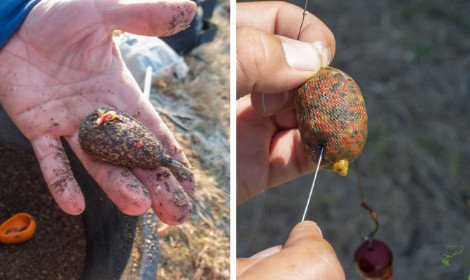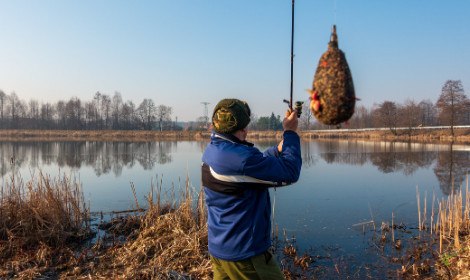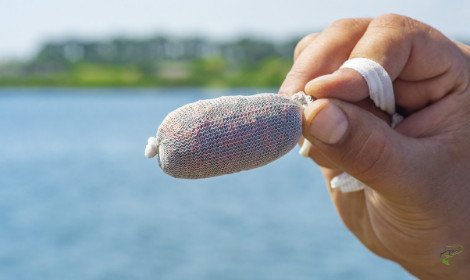
After you’re done fishing for the day, you and your friends sit down for a cold drink. The talk turns to the various fishing methods. Some swear by method feeders, while others love to fish with spods or spombs.
So naturally, someone starts comparing the different virtues of method feeders and PVA bag fishing. Both of these pack hookbaits in groundbait or micropellets for neat delivery, baiting and casting.
But the question remains, method feeder or PVA bags? Which technique is better? This debate is as old as time or, more accurately, as old as both of these methods. PVA bags are easier to fish over long distances, but method feeders are easier to load. Both of these similar techniques have anglers divided on which is the superior one.
Want to settle this debate once and for all? Let’s dive into our in-depth analysis of the pros and cons of method feeder fishing and fishing with PVA bags.
What Exactly Is Method Feeder Fishing?

Fishing with a method feeder is a fishing technique that involves using a little device called the method feeder. The method feeder is a small plastic device with a flat bottom and a top on which you can mould groundbait or pellet mixes.
Anglers neatly pack groundbait or micropellets on the method feeder, place a hookbait in between and fix it into place with a mould. When a carp begins to feed on the free loose groundbait or pellets, they come across your perfectly presented hookbait and picks it up. Then, as the carp moves away, the hookbait pierces it’s mouth with the weight of feeder ensuring a secure hold.
While method feeder fishing isn’t used as widely as before, it is still an excellent technique to catch carp and other wary fish. In addition, many consider method feeder fishing as one of the easiest way to catch carp with its easy loading method and cheap equipment.
What Exactly Is PVA Bag Fishing?

PVA stands for polyvinyl alcohol, a polymer that many know for its water-soluble properties. In PVA bag fishing, a small transparent bag made out of PVA and filled with groundbait mix, micropellets or basically any other carp mix, along with a hookbait is fished into the water.
This PVA bag starts decomposing as soon as it reaches the bottom. The groundbait or pellets start escaping, making an attractive cloud that attracts nearby carp. This works in the same way as method feeder fishing, the loose feed attracts the fish and gets them feeding comfortable around your hookbait. This technique is known for its versatility in ingredients as well as neat packing.
PVA bag fishing is prevalent these days because of how easy fishing a line with a PVA bag is. You can fish the bait quite far with tightly packed, small PVA bags. However, like all techniques, it has its cons. We’ll get into those later.
When Is Method Feeder Fishing Better?
The answer to this question mainly depends on the angler as much as the situation. For example, if the angler is repeatedly casting to bait up an area quickly and is only fishing for a short time, method feeder fishing is the better option. It is easier to load a method feeder in quick succession than it is to pack many PVA bags. Not to mention, PVA bags can get a little expensive in these scenarios.
Another scenario in which method feeder fishing is a better option is when you encounter many wary carp. In commercial fisheries or other angler hotspots, carp are used to seeing PVA bags fished around a lot.
They naturally begin to understand the danger around them and become too wary of approaching one. In these cases, using the feeder fishing method makes sense as it is a technique that fewer anglers on commercial waters use anymore.
When fishing on an island or an area with a slope, using a method feeder with a flat bottom is an excellent idea. The reason is that the flat bottom of the method feeder allows the feeder to stay on the slope or the island’s shelf, where one can usually find much fish. Other baits and rounded presentations will roll down the slope and not get any bites.
When Is PVA Bag Fishing Better?
Now, consider this. You’ve already set up your rig and settled in a peg, but you’re having no luck with the carp. You do, however, see some carp splashing around near the opposite bank. So instead of gathering all your stuff and making your way there, you can just cast farther away. And what do PVA bags do in it?
PVA bags are much more aerodynamic than simple method feeders. Once you’ve turned in the bag’s corners and made a tight little packet full of tasty treats, your PVA bag will slice through the air and land quite far. This aspect makes it helpful for fishing over long distances.
Other than that, if you have the skill for it, you can loop your prepared bags with the mainline and continue casting as soon as you reel in the old PVA bag or whatever remains of it. In this way, PVA bags save up a lot of time that anglers spend while preparing their bait when recasting.
If you wish to use some extra aromatic liquids in your mix, you can do so in your PVA bag mix as long as the liquids are not water-based. This precaution is because water-based liquids make the bags decompose before they hit the water.
If you choose to fish undercover or in a spot with lots of weed growth or lily pads, use a PVA bag to deliver your bait. This way, you’ll know that your bait isn’t going to scatter everywhere if it snags into something.
If you’re an environmentally conscious angler, PVA bags are an excellent choice for bait. Since it is made out of a degradable polymer, it decomposes within minutes of hitting the water. So, even if you lose a bag or two, you won’t lose sleep wondering if it’s in some poor fish’s stomach.
Method Feeder Fishing Tips

Method feeder fishing is a tried and tested method to catch carp. The packed bait combined with the self hooking properties makes very quick business of catching carp if you know where to cast.
So, what are some tips and tricks to perfect your method feeder routine? Let’s find out.
- The groundbait or pellet mix will make or break your method feeder routine. Make sure it’s not so dry that it disintegrates in your hands and not so wet that it’s falling off the feeder before you’ve even cast it.
- Make sure you use a short hook link. A hooklink between 3-4 inches will ensure that the hookbait catches into the fish’s mouth as soon as it pulls the bait into it’s mouth.
- Use a fluorocarbon line on bright, sunny days or in clear waters. The fish have high visibility in these situations, and you’ll end up scaring away the wary carp with a more opaque line.
- Always use a line clip for accuracy. Using it will allow you to cast your method feeder in the same spot each time.
- Colourful hookbaits are an excellent idea in the summers. You can catch the attention of hungry fish with bright colours.
- In the winters, it’s better to go with paler hookbaits. This tip helps anglers reel in sleepy, unsuspecting fish that would usually ignore colourful baits in the winters.
- Don’t wait around for the carp. Instead, cast as often as possible, as it’s unlikely to get a bite after the first five minutes of casting the method feeder.
- Don’t fish over a large area. Make sure you fish in the same spot each time so a concentrated cloud of bait forms. This cloud will attract the carp to your line.
- If you’re having an uneventful day out on the water, try switching up your hookbait. Many times, anglers receive an exponentially greater number of bites after they change their hookbaits.
- Make sure that the spot you cast your method feeder in is free of lily pads or weeds. Method feeders snag in these things and end up creating a mess.
Method feeder fishing is an incredibly convenient fishing style that anglers love because of its ability to reel in carp. However, its unreliable delivery, when handled by amateur anglers, its unreliable delivery can sometimes make fishing trips uneventful, which is why a lot of them have switched over to PVA bags fishing. However, if you stick to these tips, you’ll have a great time with method feeders!
PVA Bag Fishing Tips
PVA bag fishing is a relatively new technique to fish carp. However, it has grown steadily in popularity in the past twenty years. This increasing popularity is because of its easy usage, quick casting time, neat delivery, and biodegradable material.
So, ready to sharpen your PVA bag fishing skills? But, first, let’s get into some tips and tricks!
- Always slightly wet the corners of your PVA bags and tuck them in. This step helps to make the bag more aerodynamic and tightly packed.
- If you don’t have a string to tie the bags with, just click the top of the bag and keep it twisted for up to four seconds. This time is sufficient to make the bag seal itself.
- Add some attractive liquids such as hemp oil to your PVA bag mixture to spice up your bait. Then, add the liquid a few moments before casting it so that the groundbait or pellets have time to absorb it.
- While this is not something that you usually need on other fishing trips, make sure you keep a towel with you at all times. This way, you can wipe your hands on it before filling your bags, so you don’t accidentally poke holes in them.
- Always poke some holes into your PVA bags before casting. This step will ensure no air is trapped in the bags that could potentially weigh them down.
- Always place the hookbait a little to the side to ensure that it will go straight into the fish’s mouth when it bites the bag.
- Make sure that your PVA bag is filled with small chopped-up particles. This step will ensure that your bag is exceptionally aerodynamic and filled with many tasty treats to keep the carp occupied for as long as it takes for them to bite.
- You can also sneak in a flavoured tablet into your PVA bag for some extra attraction. The flavour tablet will continue dissolving, attracting any passing fish to the hookbait.
- PVA bags melt a little too quickly when anglers use them in hot or humid weather. Make sure to cover your PVA bag with another PVA bag to ensure maximum protection against the elements before you cast them.
- Add some dead maggots or casters to the mix to switch things up slightly if your carp gets bored with your current mixture.
Carp fishing with PVA bags is an excellent method to reel in some big fish. However, fishing with PVA bags is a lot more fun if you’re using the tips mentioned above and making the most of your much-needed fishing expedition.
Method Feeder or PVA bags?
So, the question remains, which one is the better option? Both of these methods have a lot of advantages when fishing over a wide range of conditions. By making sure that you follow all the rules associated with each method and even incorporate some new tricks into your routine, you can make the most of both techniques.
However, as is seen by its rising popularity, many anglers today prefer PVA bag fishing due to the ease with which you can load the bait into the PVA bags and cast it over large distances. That being said, you should not write off the method feeder as it is still one of the most fool proof ways to catch carp.
Conclusion
Whether it is with method feeder fishing or PVA bag fishing, a good angler can catch plenty of carp by ensuring their rig is set up correctly, and their technique is well-executed. So, whichever method you prefer to fish with, make sure you practice it enough to excel in it. The rest is history.
So, what are you waiting for? Grab your bait, some PVA bags, and some method feeders, and get to work!

